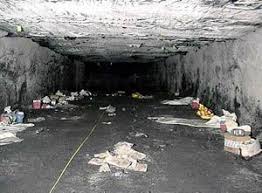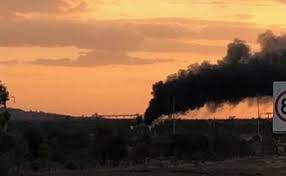
Grosvenor Inquiry INTERIM SUBMISSION Spontaneous Combustion Methane Ignition 39 to 41 C heading First Overpressure Event May 6th
Above is my Interim Submission given to the Inquiry today about the First overpressure event likely being a methane ignition in 39 to 41 cut through C hdg TG 104 (MG 103).
Ignition Source spontaneous combustion heating in small chain pillars.
The first 3 pages are below
Evidence that a spontaneous combustion heating in the smaller Pillars in TG 104 40 to 41 cut-through and a methane explosion in this location was the first overpressure event on May 6th 2020.
Ten days after the first shear on LW 104, evidence points to an advanced heating (spontaneous combustion event) at the rear of the longwall Tailgate with the confirmed presence of Ethylene from the 19th of March 2020 on.
Let us accept the well-known fact that the confirmed presence of Ethylene confirms that the heating has reached over 100 Celsius before or about the 19th of March.
Andrew Self
A Going back, early stages of my career, if we identified ethylene, we knew we had a major problem and we moved quickly.
It was absolutely acknowledged that if ethylene was detected at all, then we had a serious problem.
However, ethylene does not come off at low temperatures. You don’t get ethylene, generally speaking, at much less than 100 degrees Centigrade. I said earlier on that at 100 degrees Centigrade, I think it’s all over, we’ve lost this battle, so we’re really into damage control.
Q If a gas monitoring point, whether it be a bag sample or a person or whatever, picks up ethylene at 1 ppm, then the ethylene at the source is more than 1, because almost every sample that’s taken has been diluted to some extent.
What if, for example, you were detecting very small amounts of ethylene at 3-4 cut-through – so I’m talking about less than 1 ppm?
A Yes.
Q That’s about 4 kilometres from the face.
A Yes.
Q In, what, 70 metres per second of air. What would it tell you if you got, let’s say, 1 ppm at 3-4 cut-through about what’s going on in the goaf itself?
A Something very serious, because the dilution rate would have to be at least 70 to 1.
Evidence that points to it being a Pillar fire in the smaller Pillars in TG 104 40 to 41 cut-through.
- The ventilation shaft changed from exhaust to intake before LW first shear.
- Confirmed presence of Ethylene as early as 19th March ten days after the first shear.
- Location of detection in TG 104 (MG103) C heading 40 to 41 C/T.
- Grosvenor LW 104 Ventilation Arrangement not used anywhere in world,
- Grosvenor LW 104 Ventilation Arrangement inherent design flaws.
- Intake ventilation shaft with forcing fan arrangement at around 700Pa positive pressure.
- Arguably the highest differential pressure ever put in place at a Queensland Coal Mine in history.
- Pressure differential many multiples of recommended maximum suggested in Mining literature.
- Pressure Differential changes of 50% in week prior to May 6th,
- The smallest pillars in the TG and MG did not have their Factor of Safety calculated and would at an estimate well below the 2 identified for the Face bleeder road pillars.
- Products of Combustion including Ethylene detected at TG 3 to 4 cut through but never on the 400m TG monitoring point.
- Loss of grossly substandard segregation VCD’s in the Tailgate that induced goaf gas flows down C heading in the Tailgate.
- 1st LFI Investigation Report for gas exceedances on 6th and 7th April 2020 finalized and signed.
One of the key findings was that the VCDs within the cut-throughs were considered damaged (not able to inspect them as they are in goaf area). These VCDs were allowing the ventilation to pass through the goaf and allow gasses to bleed out into C Hdg Roadway.
- Continued presence of between 10% and 14% for 2 months of Oxygen at the back Tailgate of the block even with continuous Nitrogen injections.
- Oxygen Concentrations vary by up to 2% due to daily barometric fluctuation.
- Extreme barometric fluctuations in April and May including a “KING” barometer on May 5 to May 6.
- The Tailgate and Maingate Chain Pillar “roadways” hanging up to a much greater extent than previous LW blocks creating in effect clear goaf ventilation paths for high Oxygen levels. Witnesses “as far as you could see” ADAM MAGGS ERZC
- Effects of Ventilation System Changes on First May on goaf well gas readings.
- Apparent Ventilation System changes around the 17th of April to 19th of April for the MG Compartment – Pre-driven Recovery Road 13 .
- Post first event the readings at the TG 3 to 4 C/T are higher than the 400m monitoring point.
- Apparent direction of wind blast from first overpressure event at the LW 104 face.
- Suck back not apparent on the Longwall Face; and a ventilation dead spot on the Longwall face for the 13 to 15 seconds until the LW 104 Methane Ignition and Explosion/Deflagration on the face.
ANGLO GROSVENOR LFI JUNE 8th EXPLOSION
This REPORT includes issues ANGLO has identified with the Ventilation Arrangement in 104 PRIOR to the 6th MAY face ignition
- TG104 Ventilation Setup
A contributing factor to the ventilation pathway through the goaf that is possible to have accelerated the oxidation process, was the setup of the ventilation system for the LW104 block. In previous longwall blocks at Grosvenor, the bleeder (companion) road has been used to ventilate the second roadway. LW104 was the first block at Grosvenor where a dual return was used as there was no bleeder road as it had been successfully sealed in as part of the LW103 sealing prior to commencing production in LW104.
The strategy to manage C heading as part of the Tailgate 104 return was supported by ventsim modelling, detailed in the Second Workings SOP and submitted through to the DNRME. There were also discussions with the DNRME in advance of submitting the Second Workings SOP, particularly given the change in regulation, with no concerns raised. As such, the mine proceeded with the documented plan to run dual returns down to TG104 34c/t and thereafter a single return outbye of TG104 34c/t. The strategy included the installation of 14kPa VCDs in each cut-through from TG104 34c/t to 41c/t. While with the benefit of hindsight an alternative option could have been to install standard seals instead, it is important to note that these were not required by any regulation or procedure and the dual return setup was only planned to be short term until the longwall passed TG104 34c/t.
The 14kPa stoppings are suspected to have been compromised due to the abutment loading from LW104 (with further potential damage from the 6th May 2020 ignition event). This was identified during the investigation into the gas exceedance events that occurred on the 6th and 7th April 2020.
Actions from both the IMT and the Learning from Incidents (LFI) report, recognised the issue and the substantial stoppings were implemented as a means to control the goaf stream reporting to C Heading. Had the longwall continued to retreat past 34 c/t, it is highly unlikely that there would have been any major issues with this approach, however when combined with the events of 6th May 2020, whereby the longwall was stood for a significant period and access into the tailgate was restricted, a pathway of least resistance began to form as fresh air from the ventilation system passed through the goaf and around into C Heading rather than via the tailgate end of the longwall.
Ventsim model suggests around 50Pa-70Pa differential pressure on the TG104 C36-C37 stopping (based on the ventilation quantities in and around the LW circuit on the 6th of June). This takes into account modelling the ventilation control device in 40c/t damaged (with minimal resistance) and a brattice substantial stopping installed at C36-C37. 50Pa-70Pa pressure for a 3.7 metre by 5.4 metre roadway equates to around 100-140kg of force against the stopping. This would not be deemed to be excessive for a substantial brattice stopping constructed as per the installation permit (with snap jacks, mesh, ratchet straps etc).



Good article Stuart,
A couple of things to note that is worrisome.
Geotechnically in thick seams with soft coal there has always been a bone of contention on whether the roadway height or the seam thickness should be used in regard to pillar design. My experience with this practically, has been when we used the roadway height extra passive support was always required. Now in a 3km tailagate putting link n lok cogs skin to skin is a logistical nightmare in any ones language.
I know being a monday night quarter back is not welcome in any circumstance. However the submission and acceptance of the second workings sop shows the knowledge gap at the mine as well as the mines department, I hope this gets addressed in the Mines inquiry.
Easy for a coal mine to risk assess away spon com because the mine has not had any issue in the past, however the mines dept needs to change and step up to the mark and challenge the risk, The ventilation changes have contributed to the scenario, the logic of inertisation used was not the best, after the ethylene detection there should of been a concerted effort to identify the source of it and extinguish it asap. As mine managers our first plan is to mine and bury the source, but that logic only works when the goaf is sealed effectively and there is an inert zone formed in the goaf. Carbon dioxide really was the only inertisation tool that would have been effective since it is heavier than air it would of sat lower in the goaf as a blanket. As I said no one likes a Monday night quarterback.
keep up the good work